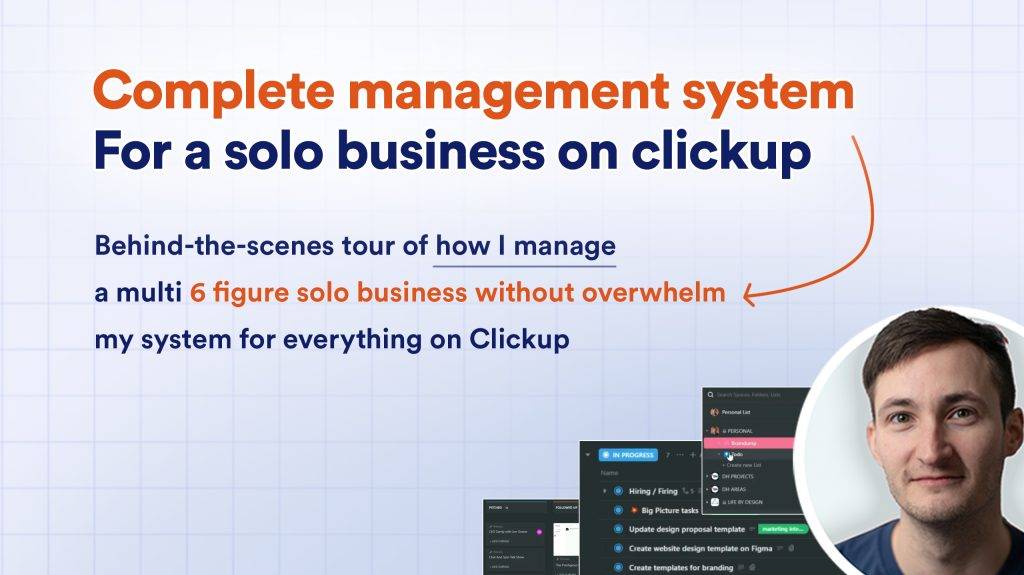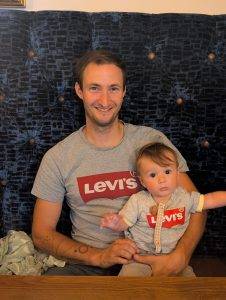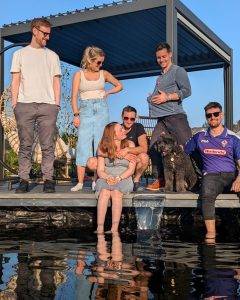This week I came back from holiday in Budapest, which was amazeballs.
But I’d hardly even boarded the plane before my mind started to fill up with all the loose threads I had to chase up.
I was facing the usual pressure of having to catch-up;
“Catch up”, As if your whole life and work was a race.
As ludicrous as it sounds, sometimes it feels like the world will fall apart if I don’t email that client for a week.
This is the hard part about being a solopreneur.
The buck stops with you,
If you stop, the business stops…
Or does it?
Actually it wasn’t nearly as bad as I imagined.
When I got home I found I had…
- 200 emails to delete,
- 20 that didn’t need any action, to skim and archive
- 4 to respond to.
- A few urgent but unimportant tasks to do.
All that stress for nothing!
By Tuesday afternoon I was back out in the garden cutting grass.
Sure there was stuff to do. But nothing that couldn’t wait.
Getting back into my routine was more important.
Getting back on track so quickly was possible because I have systems in place that keep things moving along while I’m away.
And because I’ve taken small daily actions on things,
It means that the results of those actions carry on,
Even if I stop pushing for a week or so.
- Writing weekly means I have lots of inspiration to draw from.
- Scheduling monthly means my social content continues without me.
- Automating my marketing funnel means enquiries get a personalized response even when I’m not at the keyboard.
In other words, I had built up momentum.
Momentum is like a heavy ball rolling:
it’s hard to get started, but
When you have momentum, you’re hard to stop.
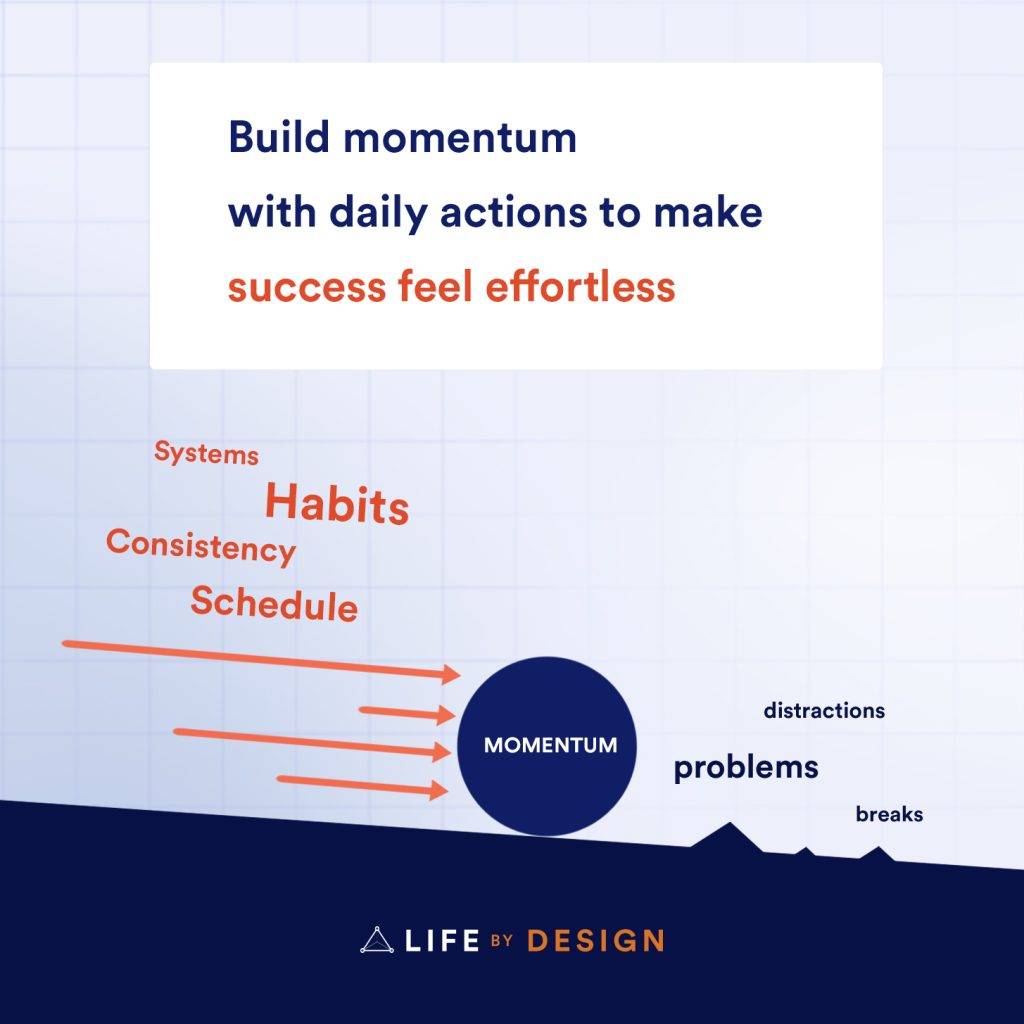
It’s like when you see a celebrity who gets their first major role,
then they’re viral on tiktok,
then they’re signing deals on perfume and sportswear,
Suddenly they are EVERYWHERE.
It seems like there’s some kind of magic, or possibly cheating going on.
💥 That’s momentum.
Momentum is a magic feeling,
where you make a continuous stream of movement towards your goals without strenuous effort,
where success seems to happen by itself.
But it isn’t magic.
There is a trick to gaining momentum,
but it isn’t cheating either.
Most of these runaway success stories didn’t just happen,
in fact they usually started a long time ago.
It’s a result of some pretty simple things at work.
A lot of the systems and processes you’ll build take a long time to set up,
But if you can hold onto momentum,
you can produce results for your business, far beyond your individual abilities,
without just pushing harder.
Even setbacks, curveballs or failures will not stop your progress overall.
When I lose my momentum, I feel that “start – stop” lurching feeling
where nothing I do seems to have much impact,
and I lose sight of what I should be doing day to day.
There is a point in any project or endeavour,
Where you make quick gains at the start,
you feel like you’re winning,
then suddenly you hit the hump.
This is where most people give up.
It’s like driving a car:
easy to get to 30 mph.
just a little bit harder to get to 60mph
much harder to get to 70mph
Success is doing the same things up to the point where you lose momentum, then carrying on.
Carrying on until the next paradigm shift or breakthrough. Long term projects have multiple humps.
At this point shiny object syndrome normally kicks in and you move onto something else and start again.
When this happens I reset myself back to x4 basic strategies to regain momentum.
I’m going to share with you the 4 things that have helped me to build unstoppable momentum in my life and work.
So here’s some simple things you can do to build that magic feeling,
a lot of people on social media call “momentum”.
But first,
a word of warning:
Momentum can work both ways.
Momentum can be an enemy
If you’re working hard on the wrong goals,
building the wrong lifestyle for yourself,
working on tasks which don’t have the right outputs,
Momentum can hold you back and make it harder to make positive change.
If you’re in the habit of watching Netflix, and snacking after dinner,
that’s a habit which will take you towards overweightness and lethargy.
Rewarding habits are the hardest to break.
You won’t even notice it. But every day you travel just a little bit in the wrong direction.
When you reach a critical point and decide to change course,
you’re going to have to backtrack all the way back to the starting point before you can start making progress.
This is why it’s easier to stay in a trap than to break free.
But the sooner you start fighting,
the easier your life will be.
How to build momentum
In my opinion,
there are only x4 parts to momentum:
- A daily schedule
- Deep focus work
- Habit tracking
- A Second Brain
1 Create a schedule and stick to it
It amazes me how many freelancers and solopreneurs don’t have a daily schedule.
They just start their day in their emails, reacting to whatever comes along,
then wonder at the end of the day why they haven’t made any progress on their own goals.
You. Are. Nuts.
If you don’t have a plan for the day then you aren’t working intentionally on the correct things.
Your schedule is a basically a pro-active form of habit tracking.
Habit tracking looks backwards at your behaviour.
Your schedule looks forwards at your potential behaviour.
Designing a schedule with the correct actions in it will keep you working on all the stuff you need to do every day to…build momentum!
If you’d like to do a deep dive on the schedule I use to run a multi 6 figure design business on a 3 day workweek you can watch my schedule design workshop for freelancers.
2 Deep focus & a habit of morning flow
I’ve said this before about lifestyle design,
you can change your whole life in one day:
You see, every day you move towards the life you want,
or further away from it.
Every choice you make each day determines your direction.
At any one time you’ll have far too many things to do,
compared to the time you have available to do them.
This is when people try to multitask, or “balance” their tasks with things like the Eisenhower matrix, or productivity apps.
The only true productivity hack is choosing to do less.
When you jump between too many different tasks, too many different priorities,
What you’re doing is diluting your efforts.
If you spread your efforts too thinly,
you’ll never get your ball up to speed.
Small bumps will stop your progress,
then you’ll have to put in MORE effort just to get back up to pace again.
The maths doesn’t really work the way you’d expect:
Put in half the effort,
and instead of make half the progress,
you’ll make none.
Conversely, by focusing on the same thing, you’re concentrating your effort rather than diluting across multiple different tasks
You avoid contact switching and each of your actions will start to have multiple outputs.
When this happens, you suddenly start seeing results that you didn’t expect in areas you didn’t expect.
Hence the “magic” appearance of momentum.
That’s why focus is a superpower which lets you direct your attention to the right things, and ignore that which does not matter.
Focus is saying no to lots of good stuff you could do,
in order to say yes to the one thing which actually matters right now.
The most common mistake I see freelancers make is pushing too many balls in different directions.
You don’t need dropshipping, and Etsy products and tshirt sales.
You just need ONE offer and ONE source of leads to get moving.
I’ve written another article with specific tips to improve your ability to focus.
This system is built around carving out a little time each morning,
before you do anything else,
before the distrctions of the day set in.
to work on your most important task without distraction.
This way you know every day you’ve moved a little closer to your goal.
Bonus tip – Build “future laziness”
We are drawn to novelty.
But if you want momentum,
it makes working on the same boring stuff every day,
until they compound into astonishing results.
Just a little effort now, saves a lot of effort later.
Don’t put it off.
If you don’t cut the grass for 3 weeks, it’s going to get to the point where you can’t get through it with the mower.
doing it quickly once a week is far more time effective.
So whenever distractions come calling…
or when you don’t feel like doing the same old thing everyday,
imagine yourself in the future.
If you let things slide is going to take you more walk to pick them back up.
So cultivate your own sense of “future laziness”
Doing the important (and sometimes boring) thing NOW will save future you doing x3 more work later.
3 Habit tracking for successful solopreneurs
Habit tracking is a way to gamify your life,
and keep you consistent over long periods of time when your attention wanders.
The tiniest actions, when turned into habits can make d ramatic changes on your life
when extrapolated out over a year.
Build small, but powerful habits and track them.
Example
The gurus all say to just post consistently on social.
although this oversimplifies things,
The reason this works, is that if you spend a few hours, then give up too early,
you won’t get results, so you’ve just wasted 10 hours.
Worse, now you’ve decided it doesn’t work, so you’ll abandon it entirely.
But if you divorce yourself from seeing results,
if you focus on the writing, instead of the sales calls,
if you continue to post the right content, eventually you will start to see inbound call requests.
When this happens, it seems to happen by magic because the two activities of writing, and sales are seemingly unrelated
But the result was an outcome of posting the right content everyday by habit.
That’s why I don’t concentrate on making sales.
instead, I built a system for consistently producing content on social media;
I just focus on producing valuable content and the sales should happen as a side effect
If I do do my job correctly,
that sale will lead to a positive testimonial
which will lead to a further sale
the content can be repurposed for other things like lead magnets and courses,
multiplying the results of your outputs.
![]()
Here’s some things I make a habit of and the impact on my life, tangible and intangible
- I call x1 enquiry per day (15 mins) = £10-20k/m
- I write x1 LBD newsletter per week (2 hours) = 800+ followers
- I walk 20 mins every morning = clarity and positivity.
- I row for 5 mins every morning = 57kg @ 12% body fat
- I perform consistency reviews daily, weekly, monthly and quarterly = consistency over years
Consistency is just working on the right thing repeatedly everyday.
If it’s important, I track the habit.
This keeps me working on it every day,
and once you have a streak, you won’t want to break it.
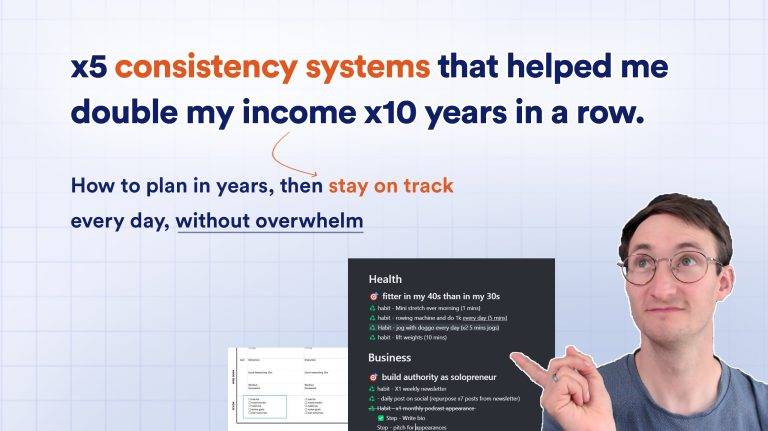
Struggle to grow consistently?
Subscribe for instant access to my system and templates for daily, weekly, monthly, quarterly and annual reviews.
4 Build a second brain
Almost all remote work is knowledge work.
Your knowledge is your most valuable output.
You have your best ideas during the day, many of them float away and are lost.
We put lots of time and effort into building something that we never look at or use again.
So find a place to capture and store them, so you can reuse them later when you need them,
without having to make them up from scratch again.
A “second brain” (also known as a PKS) is a place to store all your knowledge.
examples of Second Brains
- Clickup
- Notion
- Monday
- Google Keep
- Trello
You can use a personal knowledge system to drastically reduce the amount of time it takes to complete complex tasks.
As you grow your business you will build all sorts of assets that can be used in other areas to save you time.
Serial entrepreneurs know and use this technique all the time.
If you’d like a walkthrough of my own life management system on Clickup you can watch it below:
Part 1 – Repurpose ALL your ideas
How do so many well known creators churn out incredibly dense, valuable impressive courses in a matter of hours, which would take others months?
They store all of their work,
and reuse and repurpose the best bits into something new.
Examples:
I spent hours writing sales emails for my automated enquiry funnel, and testing them to see which had the highest open and click rates.
Later I reused these as blog posts for SEO
I then used the emails with the highest click rate and recorded a Loom to use as a lead magnet for an SEO audit.
I also use the whole funnel as a case study for lead generation systems.
Even things such as your project process can become a source of content for social media,
or an email you send to clients for onboarding.
You will be surprised at how ideas in one area of life such as fitness or health,
are also useful for business strategy or you might find some of your notes on child-rearing useful for client management.
Part 2 – Stack your skills
This repurposing and stacking effect also applies to skills.
You may already have the building blocks and foundations to scale your business.
The online environment nowadays is complicated.
It takes a lot of complementary and complex skills to succeed:
- crafting offers
- building marketing funnels
- writing landing pages
- putting together websites
All of these are individual skills which take time to learn and master
But once you’ve learned them, they very quickly come into use in all sorts of areas of your life
The first time I created my coaching program “6-figure solopreneur“, I ran my course with just one person.
This cost me huge amount of time and money and effort to do this level of work for just one person.
It was always intended to be delivered at scale to groups.
I could have refunded or cancelled, but I took the mindset that I was getting paid to learn and create something important.
This means that for any future students entering the same programme, it was 10% of the work for the same amount of money and effort.
In my design agency I often learned new skills whilst getting paid to do so in this way.
But this time with the the course, I didn’t build it from scratch.
instead, I assembled (most of) the lessons from various resources I already had.
- I repurposed scripts from 1-1 calls into a shorter, concentrated lesson.
- I remade workshops that I had ran as slide decks
- I expanded lead magnets into bonus templates and resources
- I rewrote episodes of Life by Design and used them as scripts for new workshops
- etc
100’s of hours of work, repurposed into a 16 part course.
to promote it I used all the stuff I had learned from all my coaching, and design agency experience:
- customer paint points
- How to write copy that converts
- How to sell on phone calls
- how to set up automations for checkins and followups etc.
All of the above are skills I spent a long time learning, but once learned I use them every day.
The sooner you start learning, the earlier you can start stacking them, the more time you’ll save.

Struggle to grow consistently?
Subscribe for instant access to my system and templates for daily, weekly, monthly, quarterly and annual reviews.

